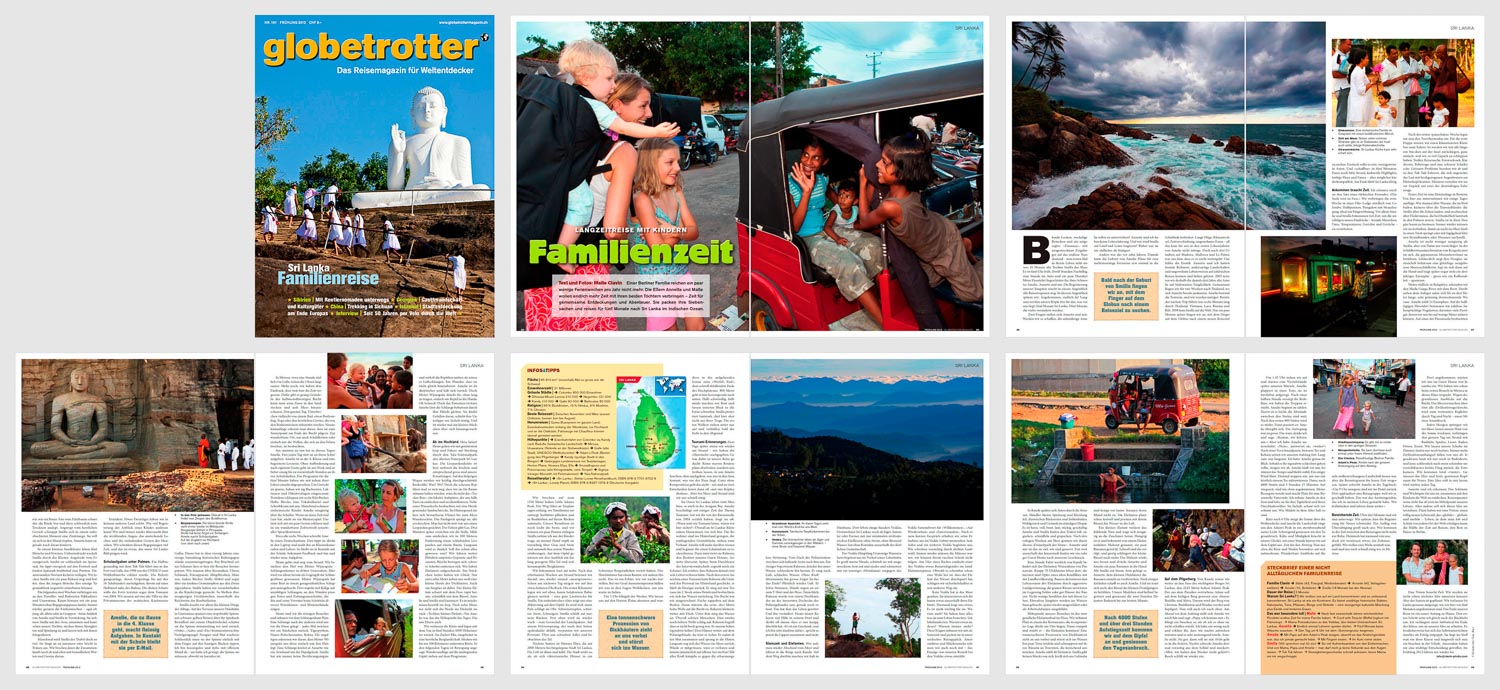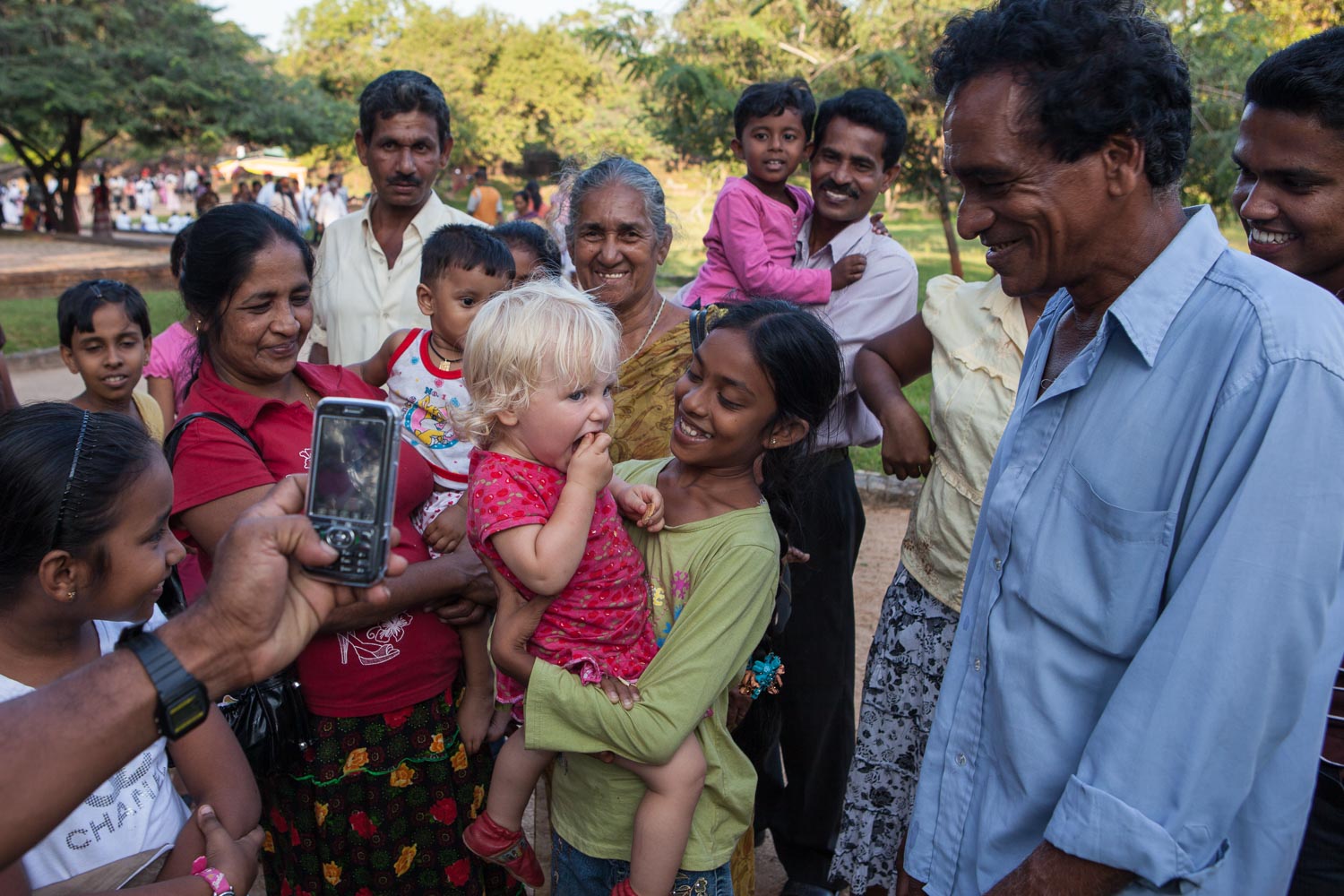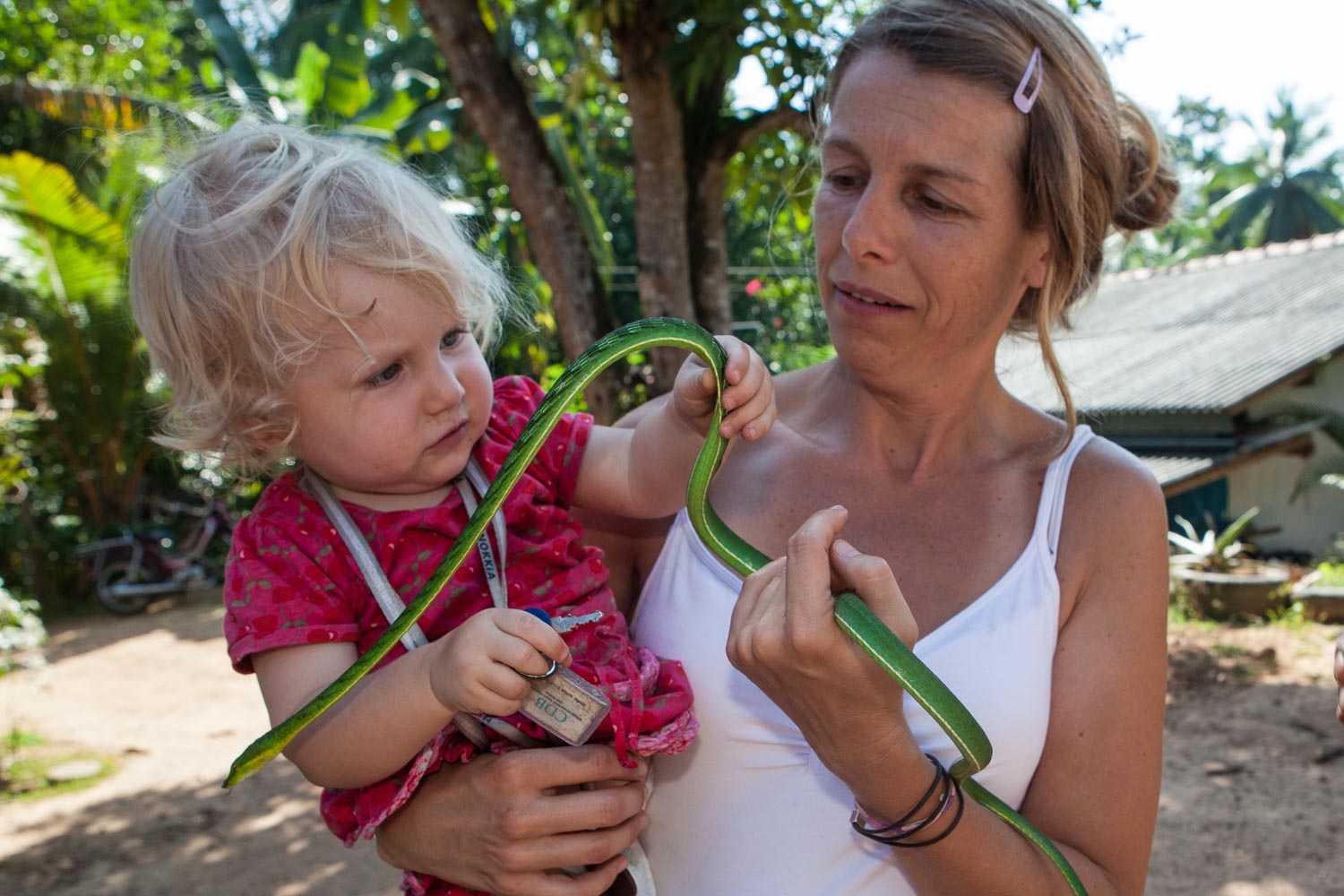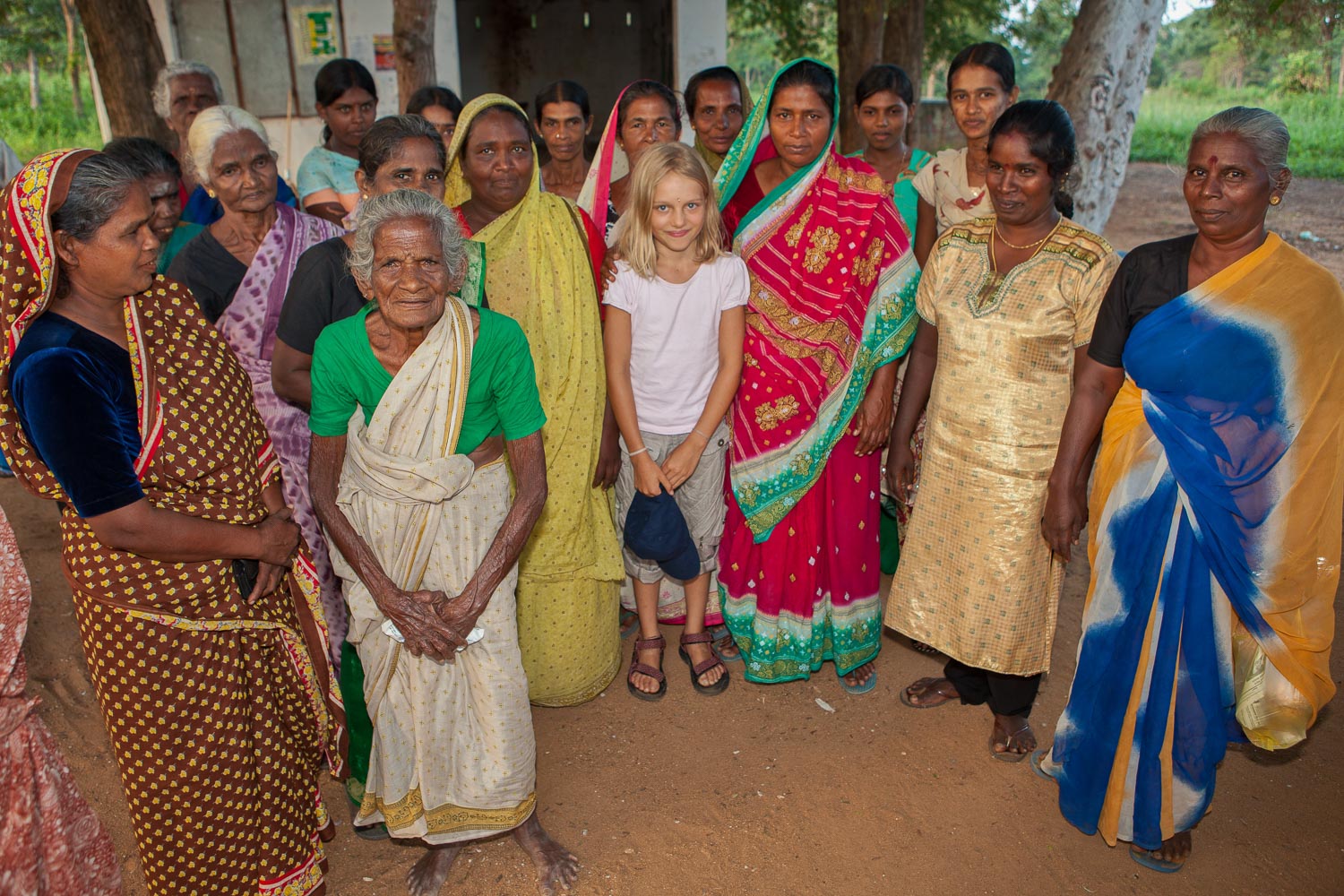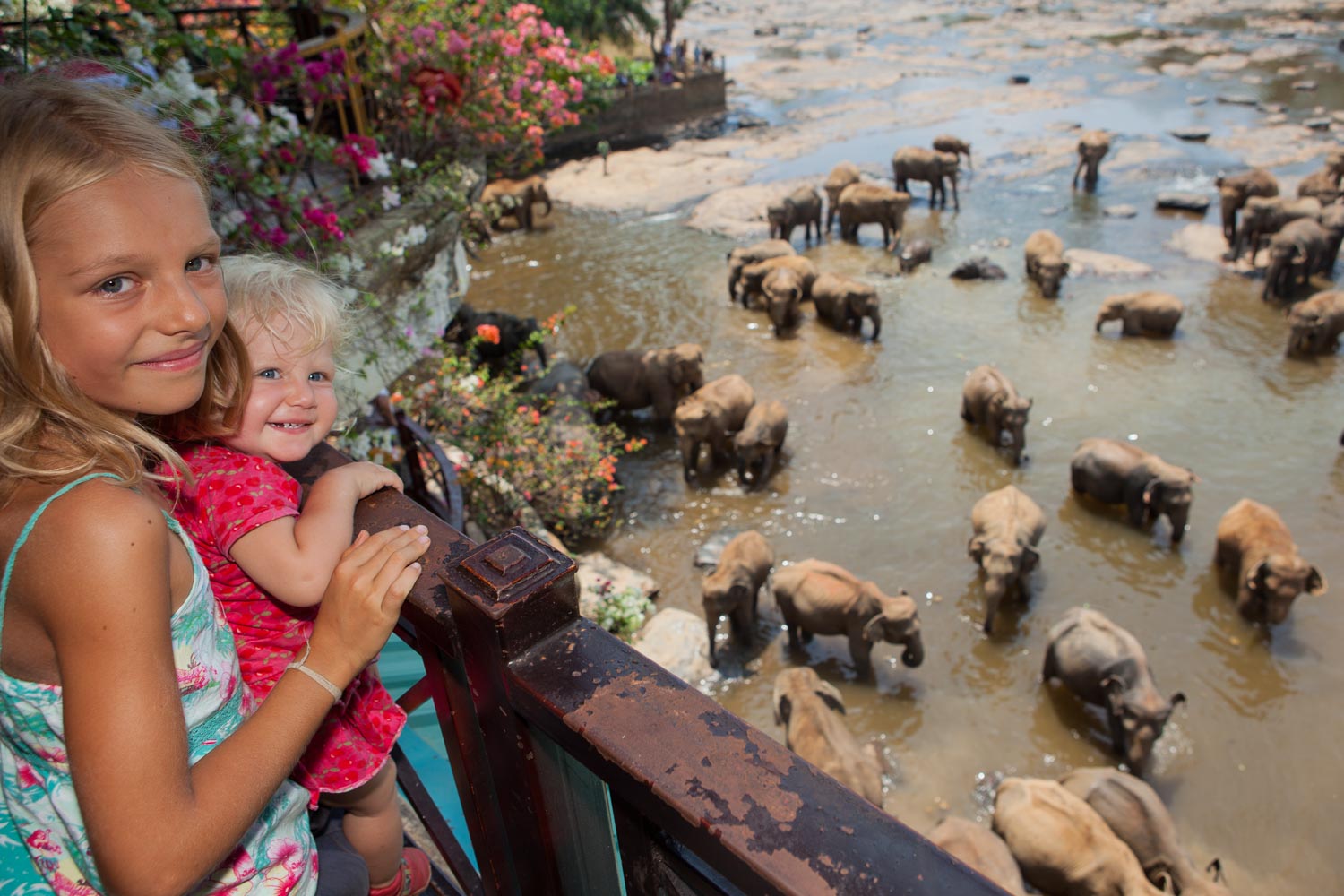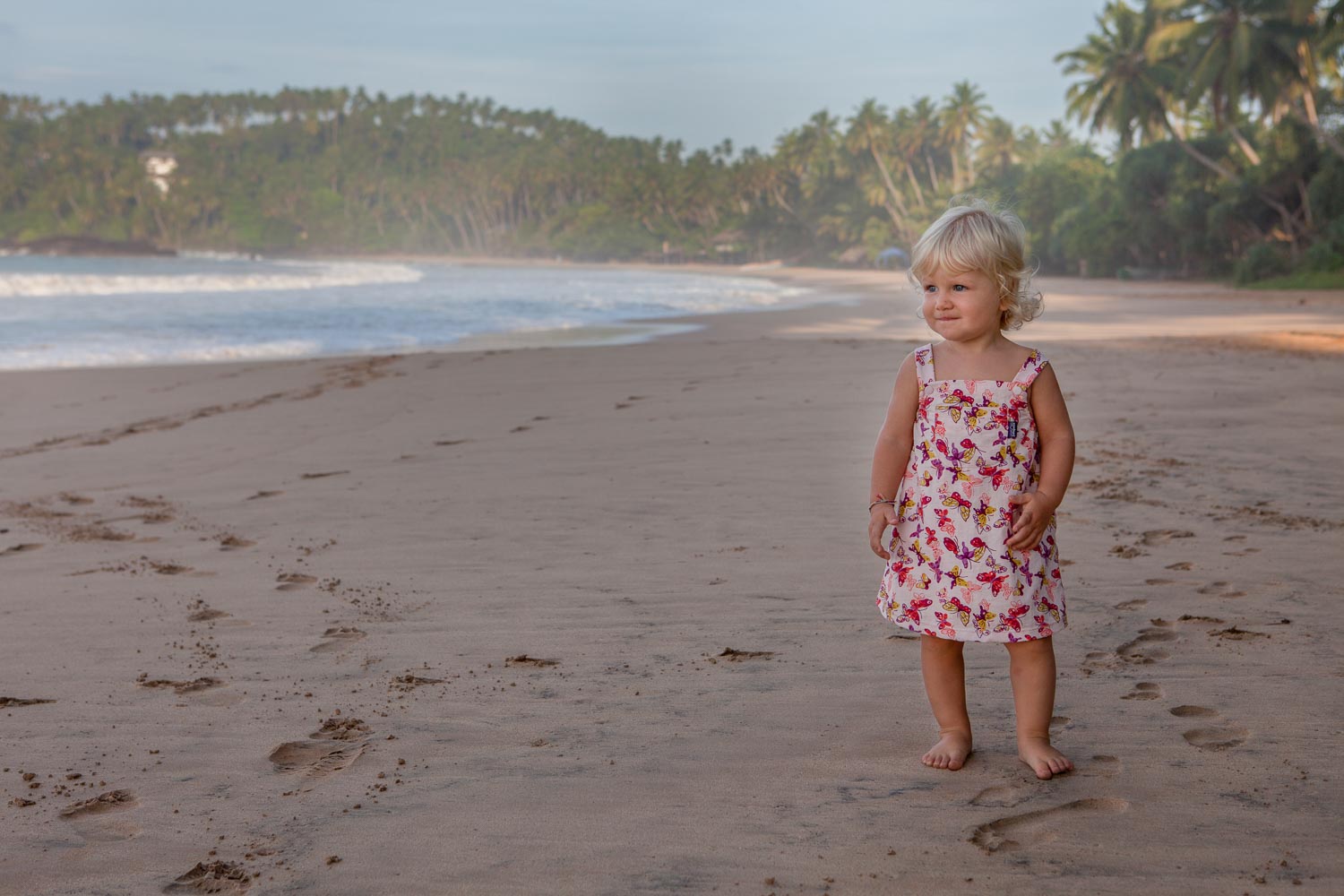Published in:

Switzerland’s biggest travel magazine
Cover story | 10 pages | text & photography
When a family’s lifelong dreams come true – 5 months in Sri Lanka
Blonde curls, wobbly little legs and an excited “Daaaaaa”, with an outstretched forefinger pointing to an endless stretch of water – for the first time in her life, our 16-month-old daughter Smilla sees the sea. It’s five o’clock in the morning. A twelve hour night-time flight, a one hour drive and a few hundred metres on a raft lie behind Smilla, her sister Amelie, Annette and me.
In the blink of an eye the enthusiasm of our youngest erases all travel related stress. In that moment we feel: arrived. Finally there! Slowly our heads clear to what lies ahead: Five months Sri Lanka. Five months that will make a difference.
Annette and I are asking ourselves two things: will we be able to teach ten-year-old Amelie ourselves? We have no teaching experience. And how will Smilla cope with the country and its people? Up until now she has never been south of Stuttgart.
It was different ten years ago. At the time, Amelie‘s birth put plans for overseas travel for a period of several months on halt. Long distance flights, a different climate, different time zones, unfamiliar food – all this was out of the question for us in the first years of Amelie’s life.
But after three holidays on Madeira, Mallorca and La Palma, it became clear that we couldn’t go on like this: we were missing the exotic. Annette and I had got to know and love foreign cultures, other landscapes and unfamiliar customs on numerous overseas journeys. So in 2003 we tested Amelie, who was three years old at the time, for her suitability for South-East Asia.
Together we flew to Thailand for four weeks, where Annette already knew her way around. Amelie passed the test trip with flying colours – and we got bolder: the very next journey took us for a six month trip through Thailand, Vietnam, Laos, Burma and Bali. In 2008 Smilla was born.
A few months later only, with our finger on the globe, we started looking for a new travel destination. Exotic it would have to be, preferably Asia. And “doable” in five months. Then please beach, cultural highlights, colourful flora & fauna – everything as child-friendly as possible. In the end, it was Sri Lanka.
Arriving takes time. I remember the phrase of a Turkish friend: “The soul travels on foot”. We spend the first week in an eco-lodge north of Colombo. Half-board, bungalow with beach access, ideal for settling in. Especially Amelie and Smilla get a lot of time to process the countless new impressions – foreign people, animals, temperatures, dishes and smells.
Finally in Traveller Mode
After the first, “all-inclusive” week, we now go into traveller mode. For the first stage we rent an air-conditioned minibus with a driver. This is how we will cover most of our long-distance trips on the island.
We carry six large pieces of luggage: trolley, travel bag, photo backpack, child seat, baby carrier and a 6 kg schoolbag. We also cause major problems for the tuk-tuk drivers, who scratch their heads with raised eyebrows when they see the load. Most of the time we divide our luggage between two of the three-wheeled vehicles.
First stop is Bentota, from here we will do some day trips. At the Ayubowan Resort we marvel at monitor lizards bathing in the pool, giggle at the centipedes running over Smilla’s toes and are startled by bats clamouring loudly in the palm trees after dark. Smilla’s curiosity can hardly be stopped. Again and again we have to hold her back so that she doesn’t walk into the sea, jump into a pond or, with a hunting howl, chase small beach dogs or monitor lizards.
Soon after Smilla was born, we started looking for a destination with our finger on the globe.
The abundant fauna whets our appetite and we are already guessing what local delicacies will be served for dinner. To our amazement, we are served Zürcher Geschnetzeltes with Rösti and red cabbage: resort manager Walter Hubacher was born in Switzerland. He has been living in Sri Lanka for several years now and learned to forego many things from his home country – except where food is concerned. And so, with endless patience, he trained his chefs to prepare Swiss cuisine and treats his guests to delicacies from his homeland.
Amelie is no less curious than Smilla, but more cautious by nature. At the Kosgoda turtle nursery, she is reluctant to touch the armoured sea creatures. Eventually her curiosity wins out, she gently strokes a slippery newborn sea turtle, then puts it on her hand and later even proudly carries a three-year-old specimen – as big as a coffee tray – for a walk.
Further south, in Balapitiya, we explore the Madu Ganga river by boat. Right next to the jetty, up to three-metre-long, grim-looking monitor lizards are basking in the sun. Amelie counts 21 of them.
During the half-day river trip we marvel at countless colourful bird species, including many kingfishers, which we can approach to within a few metres. On one of the river islands we watch a farmer cutting branches from a cinnamon tree, loosening the bark and finally laying it out to dry. Inspired by the wonderful smell, in an unobserved moment Smilla grabs a cinnamon stick. She wants to stuff it into her mouth; just in time Annette is able to stop her.
Afterwards we visit a small island monastery where five monks and novices live. Unimpressed, Smilla totters through the monastery and, lured by the smell of food, finally ends up in the dining hall. Vigorously she bangs on the dining table and loudly jabbers her demand for a serving. The attendant novices chuckle awkwardly. With a few biscuits we coax Smilla out of the kitchen again and hope that the novices can have their only meal of the day without interruption now.
Smilla and her usual “fan base”. Pollonaruwa: An extended Sri Lankan family streams towards us and in the next quarter of an hour Smilla wanders from one arm to the next. Countless mobile phones snap souvenir photos. Smilla is bribed with biscuits and takes everything very calmly.
Along the coast
The next two weeks we spend at the traveller and seaside resorts of Hikkaduwa and Unawatuna. We can hardly walk a few minutes without being held up: again and again, the Sri Lankans – young, old, alone or in groups – are ecstatic at the sight of Amelie and Smilla. They take Smilla in their arms, hug and cuddle our daughters, give them sweets and toys and have their picture taken with them.
But at times the hustle and bustle gets too much for Smilla. Despite being bribed with sweets, she can start to whinge or bursts into tears. We then quickly break off the encounter and with amicable words and gestures, hurry on.
Yet, we have never experienced anything like this in any other country. The amount of enthusiasm the sight of a child can trigger! We are always surprised by the bright shiny eyes, the contagious laughter and the welcoming signs of the Sri Lankans. We donate a lot of time to these encounters and it is something that will characterise our impression of Sri Lanka. Later, back in Germany, we will often reminisce about it and refer to it again and again.
Several times a day we pass Mike’s souvenir stall in Unawatuna. That’s the name of the old Sri Lankan with the crumpled face and a short white hair. When he sees Amelie and Smilla, he shouts “Ah, come here girls, I have a present for you!” and puts a necklace or bracelet on them.
Mike gives the raucus whirlwind Smilla the nickname ‘Devil’. Amelie he christens ‘Trouble’. The reason: “In a few years only she will go out with a lot of boys. And then you will have a lot of … trouble! Hahaha!”.
All down to Galle
A tuk-tuk takes us on a half-day excursion to Galle Fort, declared a World Heritage Site by UNESCO in 1998. The fortification, the origins of which date back to the 16th century, juts out from a peninsula near the harbour. The fort’s thick ramparts even withstood the 2004 tsunami.
We head for an old villa, the private museum of the Arab merchant Gaffar. In over forty years, he has amassed a huge collection of cultural objects of historical value. Only a fraction of his treasure is exhibited for visitors here. We marvel at all the ceramics, watches, jewellery, cameras, dowry chests, coins, anchors, books, fabrics, furniture and even an intact gramophone from the 1920s.
We take the precaution of putting Smilla in the baby carrier. This keeps the precious objects out of reach of her curious little grappling arms. Smilla’s interest in things from the “adult world” is limited.
Mostly it is the very small things of everyday life that capture her attention: on the terrace of our wooden cabin in Unawatuna, a pretty large spider with black and yellow legs walks across her playing blanket. Armed with a lens cap, she pushes the spider back and forth for minutes. Oohs, Aahs and Da! accompany her chase. Curiosity and courage increase. Finally she just can‘t stop herself from tapping with her finger on the spider’s hairy back.
I stare with open mouthed astonishment – I would have never dared touching the revolting thing.
Second home Mirissa
In Mirissa, time passes slowly. Moreover, we get the impression that here many people forget time. Ample reason for that: in the crescent-shaped bay you can put your feet in the sand and look out over the sea. All day long. Interrupted perhaps by a swim, some bodysurfing, yoga or the delicious curries prepared by the locals.
You can spot the new arrivals by their pilgrimage to Sunsetpoint at the end of the bay. A wonderful place also to watch turtles or just observe the waves breaking on the rocks. On the other side of the bay, a palm-covered headland stretches out into the sea. A few guesthouses hide beneath the canopy. But only one of them offers a magnificent view of the bay. In a few months we will return to Mirissa and move in there.
Little by little, eventually we also are taken up by Mirissa’s slowness. We enjoy endless breakfasts and wonderful lazy days on the beach. Fresh fruit juices, pancakes, curries. Playing cards, salt water, sand castles. We come down, “unwind”.
Amelie, who is in grade 4 at home, is busy doing assignments. She keeps in touch with the school by e-mail.
Cramming under the palm trees
These days Amelie is the one who has most to do. Almost every day she is busy with her schoolwork. Amelie is in grade 4 and is an avid pupil. Without prompting her and on her own initiative, she takes up her tasks and works diligently on her workbooks for up to 2.5 hours. We went through the curriculum for the five months with each of her teachers individually.
To save weight, we scanned so many pages, lessons and dictation templates. Nevertheless, we are weighted down with six kilos of books, notebooks, notepads, vocabulary learning cards and assorted writing materials. Sometimes local children get curious and peer over Amelie’s shoulder. If Amelie feels like it and has time to spare, she pulls out a memory game. It can be shown in simple sign language and is a wonderful pastime across all language barriers.
Amelie writes a German essay about every six weeks. She keys it in on the laptop and emails it to classmates and teachers. In this way she keeps in touch with the school, gets feedback and new assignments every now and then.
The snake farm
Today we leave the beach behind. We visit the farm of Mister Wijayapala – a third generation snake farmer. Here mainly serum is produced as an antidote for snakebites.
Mister Wijayapala has housed his hatchlings in a garage-like shed. Cages with a countless number of snakes are piled up here, and the walls are plastered with pictures and newspaper clippings showing him and his forefathers shaking hands with various presidents and ministers. We are the only visitors and take a seat in front of the snake house.
One snake after the other is placed before our feet – each time we retreat a little. Tiger python, nose whip snake, cobra. We identify the non-poisonous ones by the fact that Mister Wijayapala simply puts them around our necks. He ties a snake around Annette’s wrist like a bracelet.
As always, Smilla has no fear of contact and whirls the reptiles around as if they were paper streamers. It’s a miracle she doesn’t bite into them right away. Amelie is more wary and stays back. But without asking, Mr. Wijayapala simply places a reptile on the palms of her hands. Oh my God! But the horror is short-lived. Gingerly Amelie allows the snake to slither through her hands. Then she even takes a liking to it, pushes her lower lip forward, smiles bravely. And once again has surpassed herself.
I will repeatedly remind Amelie of this experience. Every time when there is a need to rein in fear or show a bit of courage. “Do you remember the snake farm in Sri Lanka…”. It works. Not always, but often it does.
Smilla and Annette examine a harmless nose whip snake.
Yala
Heia Safari! Today we go on a foray through Sri Lanka’s oldest nature reserve by rented jeep and driver. The leopard density is supposed to be the highest in the world here and our expectations are correspondingly high. On the bumpy roads we keep bouncing around. Crocodiles! What! Where? But the shy reptiles are so far away that we take them to be tree trunks.
If it weren’t for the “tracker boy”, a local tracker who helps us spot and identify animals, we wouldn’t have noticed. Near a waterhole we observe a herd of silently grazing sambar deer. In the background, overgrown dunes stretch all the way to the sea. Beautiful. The radio crackles, startling everyone. A tracker boy has spotted a leopard not too far away. We step on it. Three minutes later we reach the spot. With effort we can make out a sleeping leopard on a tree 200 metres away.
Slowly it gets dark. Is that all there is to it? We continue on. Suddenly outraged snarls and trombones, bushes move, heavy footsteps move away from us. We have scared off elephants. A little further on we are lucky: a small herd of elephants only about 10 metres away from us. There is also a cub. The little proboscidean paws with its fore hoof, gropes around, sniffs with its trunk. Amelie and Smilla are fascinated. It is dead silent in the jeep.
After ten minutes, the herd retreats into the thicket. “Bye, little elephant” For Amelie this was the highlight of the day. For us as parents too.
Off to the highlands
We leave the coast and travelling by van manage 1000 metres in altitude in five hours. At our destination, Ella, embedded in magnificent mountainous scenery, we can look as far as the coast a 100 kilometres away. In the following days, exercise is the order of the day: hiking trips to the surrounding peaks are on the agenda.
The next morning we set off for the 1350 metre high Little Adams Peak. The path leads along tea plantations where Tamil women are unswervingly picking tea leaves and collecting them in raffia baskets on their backs. We are not in top shape yet and we have to take a few breaks. I take Smilla out of the baby carrier, she trudges carefully over grass and stone holding my hand and gains her first hiking experience. At the summit, we enjoy the view over the long Ella valley and the mountain ridges dotted with clouds.
We feel like doing more. After the relaxing weeks on the beach, we are eager to “work out” again. The very next day we climb the somewhat higher Ella Rock. The first kilometres we walk on old, hardly used railway tracks, a good running track for Smilla.
A local elderly man mentions a shortcut to the summit. With a pipe in his mouth, he leads the way. It gets steep, my heartbeat throbs in my ears. Sweat dripping, heavy breathing, silence. Smilla is asleep. Only at the top does she wake up again – to the rustling as we start on the packed lunches. On a rocky outcrop that spectacularly drops away on three sides, we gobble up our eats. Above us eagles hover and monitor the valley.
On the way back a group of five Americans comes down the path. Suddenly one of them yells “Snake, snake, a cobra!” Everybody halts, scanning the terrain. “Where, where?” But by now the snake has disappeared. Eventually everybody calms down, gives the place where the deadly snake had been sighted a wide berth. Amelie is close to tears. We continue on our way, stamping our feet vigorously to drive away possible reptiles.
Suddenly one of them yells “Snake, snake, a cobra!” Everybody halts, scanning the terrain.
From the end of the world back to the sea
We head for Nuwara Eliya, the highest town in Sri Lanka at 2000 metres altitude. The air is thin, cool. The town looks like Victorian houses lost in a Swiss mountain village. The hotel room has a fireplace, we don’t use it. That is a mistake, as we discover at night. At four degrees outside, to keep warm we wrap ourselves in three layers of woollen blankets. 5 o’clock.
The alarm goes off. We are dropped off on the Horton Plains and as the sun is rising we walk towards “World’s End”, the steep drop at the end of the plateau. 800 metres straight down. A bit dizzy and tired we take a break and let our eyes wander into the distance. Smilla vocally remonstrates but is not allowed out of her sling here. The first clouds are gathering down below and will soon obscure the view into the deep.
Tsunami
Two days later we are sitting on the beach again, we have given in to our sea-longing. This is exactly what our journey is meant for: not to rigidly follow planned routes, but to just let ourselves drift, to listen to our inner voices, to follow what comes to mind, what is in right in front of us. It is not possible without compromises, there are four of us. Deciding often means “thinking with four heads”, as I call it. But we quickly agree on sea and beach.
There are many Muslims living in the east of Sri Lanka, like in Arugam Bay. As yet few tourists have enough courage to come here, the area was the scene of the civil war until recently. Heavily armed soldiers patrol the beach.
Amelie has been preoccupied with a completely different kind of violence for some time: tsunamis. Since we told her about the giant wave of 2004, she often asks, “If a tsunami came now, would we be safe here?” All along Sri Lanka’s coast, ruined houses are rotting away. The residents have moved inland, and the surrounding properties are for sale.
Amelie wants to know more about it and starts researching for a school essay. She interviews Raheem, the owner of our guest house. Annette translates. Later, while reading through the interview transcript, I am horrified: I find out that Raheem almost lost his life back then: after the first advance of the water, Raheem had sent all the guests and staff into the hinterland, he was the only one who stayed behind. He ascended to a balcony on the 2nd floor of his hotel and watched the water recede.
The bay looked as if it had dried up, fish wriggling on the bottom. Then the first wave, three metres high, rushed towards the bay. Raheem climbed further up onto the roof. Below him, the water was rising. People were screaming everywhere. A second, even higher wave hit. Raheem realised he was not high up enough. He had to get higher, somehow higher! Two houses down, on top of the police building, he would be safe there. He gathered all his courage and jumped into the floods.
Slowly the water receded into the sea. Swept away, he would be doomed, he would die miserably on the open sea! With all his might he fought against the merciless current. Helping arms reached out to him from the roof of the police station. A huge undertow took hold of Raheem, pushed him under water, flung him around. He struggled for breath, swallowed water. No more strength, indescribable fear took hold of him. Is this the end?
Suddenly air again. He heard voices. Hands were pulling at his T-shirt and trousers. As it happened, Raheem was caught just in time by a neighbour crouching at the far corner of the police building’s roof. That saved his life. And changed him. Today, Raheem does a lot of aid work in his village and often thinks about the fact that he is still alive. “It is a gift and I am very grateful.” he says, nodding while pressing his lips together.
We are grateful to have been able to hear Raheem’s story. It is one of those stories that you‘ll never forget. That is always brought up again: “Do you remember Raheem…”. It is wonderful that Amelie was able to experience this. Once again, our family chronicle has grown a little.
After the civil war ended in 2009, these women and their families were taken into care in a GIZ refugee village. In good months, they manage to save about 100 rupees. That is the equivalent of 1.50 euros. Amelie may find that hard to believe: that is a fraction of her monthly pocket money.
Amelie’s birthday and a special well-wisher
Amelie’s 10th birthday happens to be on a traveling day. Nevertheless, we start the day with a hearty breakfast at Monty’s Hotel – the best address in town. We ourselves are staying in a cheap guest house, saving money is a must.
To our surprise, our table at Monty’s is lovingly decorated with flowers, palm leaves and balloons. In huge letters, “Happy Birthday” is written on the tablecloth with grains of rice. Before we have even recovered from our amazement, the restaurant staff sings this very song on top of their voices. With a broad grin a waitress places a bright pink birthday cake right in front of Amelie.
Wow! The night before, down the street, by chance I got to know the hotel manager and asked him for a little attention for breakfast. He didn’t miss the chance to make something big out of it right away.
After many words of thanks, shaken hands and a generous contribution to the staff, we move on to Batticaloa. Having arrived at the hotel, I join Smilla for an afternoon nap. Amelies writes in her diary: “When Mama ordered a lime soda, a man came up and asked if I was from Germany. Then I said “yes”.
In the evening, the man invited dad for a glass of wine. Then they chatted. In German, because Jens is the German ambassador to Sri Lanka. And when he heard that it was my birthday today, I got a cap, a key ring and something to attach to my T-shirt.“
Ambassador Jens Plötner invites Amelie and me to accompany him on a visit to a GTZ (Gesellschaft für technische Zusammenarbeit) project. The project is about the resettlement and education of female civil war refugees, mainly Tamil women. Some of the women had to flee ten times due to the civil war and resettle again and again.
A major problem is the restoration of land ownership: after the end of the war in May 2009, many returned home only to discover that their land had been occupied. GTZ provides these people with a plot of land for farming and as a place to settle, and also runs a school for adults. Ambassador Plötner takes his time: he listens to the women thoughtfully, asks a lot of questions, jokes.
The GTZ project is bearing fruit – in the truest sense of the word: we sample the beans and corncobs that were presented to us touring the croplands. For the women who benefit, this is a new life, albeit an arduous one: in a good month, they manage to save about 100 rupees, the equivalent of 70 euro cents. Amelie finds it hard to believe, it is much less than her monthly pocket money.
Back to the Stone Age
We say goodbye to the sea for the time being and drive up to Kandy, the second largest city in Sri Lanka. On the way we stop in Dambana. There, several hundred Veddas, indigenous people of Sri Lanka, still live as hunter gatherers or farmers with only minimal influence of civilisation: No electricity, no running water, hardly any contact with people outside the village community.
Vedda chief Uruwarige Wanniya-laeto welcomes us in the front yard of his mud hut. He grabs my hands, shakes them up and down with an outstretched arm and belts out a tenor like “Hondamai”, the Vedda collective word for “welcome”, “goodbye” and “agreed”. After a short conversation, we get his permission to look around the Vedda territory. His son and another Vedda accompany us.
At the edge of a rice field we see a wooden watchtower. From the gestures, facial expressions and fragments of English, the Veddas make us understand that this is an elephant warning tower. The grey giants are considered extremely dangerous here. For centuries, almost every encounter between a Vedda and elephant has resulted in the death of one or the other. A real hereditary enmity.
We cautiously traverse the dense deciduous forest. Again and again the men have to pause, we can’t keep up with their fast pace. On the bank of a stream, one of the Veddas discovers something unsettling in the sand: elephant tracks. Although it has already been a while since the elephant crossed the stream, just to be on the safe side we now take a different path.
In the hut of Guna Bandiya I ask the Veddas about things outside their habitat: Barak Obama, George W. Bush, 11 September 2001, Gandhi, Adolf Hitler. Apart from “Bush”, they don’t know any of these things. I have further questions: World War II? The 75-year-old Kiri Bandiya mumbles “That must have been during the time of the English” Internet? Vijaiatho, 48, replies “They have that in Mahiyangana” He points a waggling index finger in the direction of the town 15 kilometres away.
No Vedda has ever seen the sea, no one asks us anything. Veddas are hardly interested in anything outside their habitat. It is not important to them. Why should it? They have everything they need to live here. Have had for centuries. Why something else? Why more and more?
We take these questions with us as souvenirs and pack them in our mental luggage. Sometimes we dig them up again. Usually when one of us has fallen in love with something and wants it so very much. We also take ant bites and mosquito bites with us – the only things that cloud our visit to the Veddas a little.
Pinnawala, elephant orphanage: over 60 large and small pachyderms bathe in the river every day, a unique spectacle for Amelie and Smilla.
Kandy – not just sweet
With over 160,000 inhabitants, Kandy is the second largest city in Sri Lanka. It’s an Indian city: cars bustle through the streets, traders sell toys and clothes, and in between there are bakeries and snack bars. Sweet fragrances and a terrible stench alternate. It is hot, crowded, colourful, loud, stuffy, busy. Amelie and Smilla love the hustle and bustle, they look, sniff and grab. After the quiet weeks by the sea, we treat them to this “amusement park of the senses”. Annette and I find it just too much, we are annoyed. Only far outside the city centre do we find a quiet guest house to our liking.
An hour’s drive west of Kandy is the elephant orphanage of Pinnawala. Almost 70 pachyderms live there, most of them victim of a long running conflict with the rural population. Farmers have decimated the elephants’ habitat through intrusive land development, and in return the grey giants destroy the farmers’ fields or even houses. Quite a few pay for this with their lives. Parentless young animals are brought to an orphanage, later to be released back into the wild or trained as working elephants.
The highlight of our visit is elephant bathing in the river in the morning. We take a seat in one of the restaurants located right on the riverbank. Expectant chatter from tourist groups fills the air, growing louder. My mood deteriorates accordingly. But then everything changes: there is a rumbling, dust in the air, the elephants are coming!
A procession of pachyderms weighing tons passes by and the animals plunge into the waters. Some of them linger and with their trunks sniff at tourists, who scream and attempt to dodge. Amelie counts 46 elephants.
Smilla doesn’t utter a sound, clings to the railing and can’t close her mouth from sheer amazement. The elephants splash around with abandon, blow water into the air with their trunks, place their trunks on the shoulders of others as if to say: “Boy, it’s going to be all right.”
A small elephant leaves the cooling waters and inquisitively ventures towards the spectators. Apparently hungry, it is handed a few bananas by an elephant keeper called a mahout. They are quickly devoured and the little trunk greedily aims for more. The mahout beckons and hands Annette and Amelie a few bananas. With Smilla on her arm, one by one Annette manages to offer the little pachyderm the bananas.
After a few attempts, Amelie succeeds as well. And she does have the courage to touch the little daredevil’s trunk. Our girls are elated and enjoy the two hours of elephant bathing time up to the last minute.
With Amelie on Adam’s Peak
From Kandy we travel onwards to the foot of Sri Lanka’s most notable mountain, 2243 metre high Adam’s Peak. Adam, who was expelled from paradise, is said to have been on the top of the Holy Mountain, as well as Buddha and Shiva. That is why the mountain is a site of pilgrimage and revered by Christians, Buddhists and Hindus alike. Now I also want to go up.
The night before the climb, Amelie stands in front of me and says, “Dad, I’m coming with you” It sounds a bit as if I wouldn’t make it without her. I check her out first and explain that we will have to get up in the middle of the night and that it will be demanding. But Amelie nods. All right then she can come along. We hit the sack early. At night, Amelie wakes up three times prematurely and grumbles: “Shit, we didn’t hear the alarm clock! Quickly she falls asleep again. At 1.45 a.m. we get up and start our trek a quarter of an hour later.
Amelie chatters frantically non-stop, she is extremely excited. After half an hour, the stream of words falters, we have reached the staircases. Amelie starts to count At first it’s easy, with quite some distance between the steps. We cover the first 800 steps, it gets steeper.
Then it happens: Amelie has to throw up. The excitement was too big. That’s it, I think, and say: “Come, let’s turn back”. But I underestimate Amelie: “No” she replies, “Let‘s keep going!” After a break, hot tea and biscuits we continue our ascend.
Slowly, just slowly. I keep an eye on Amelie. As soon as somehow I would have the feeling she is doing worse, we would head back down again. Amelie stays ahead of me, sets the pace and shows resilience. An icy wind blows. Three times we take a break to warm up with delicious sweet tea. Then, after 4800 steps and a 3 hours and 15 minutes ascent, we reach the top.
My concerns fade and are replaced by a huge wave of fatherly pride. I take Amelie in my arms and praise her for her bravery and perseverance. She smiles, looks around coyly. Just the way girls are at that age. Shortly after 6 o’clock the sun climbs above the clouds and bathes the scenery around Adam’s Peak in a breathtakingly delicate light. In silence we enjoy the beauty of daybreak.
The chill and tiredness slowly creep into our bones, for an hour now we have been holding out on the summit. Time for descent. We particularly feel our knees and calves now. For a moment wonderful views of the partly cloudy scenery make us forget the strain on our legs. Amelie’s diary continues: “At 9 am we are back at the hotel.
There, a tour group aplaused (Malte’s note: applauded) because we made it. That was the hardest thing I ever did in my life. We have breakfast and drive on.“
Mirissa. Early in the morning, Smilla and I walk along the beach. In the background on the left, a white wall of houses peeks out from the palm trees. We will stay there for a few weeks.
Time out from time out
We have been on the road for over three months now. We feel that the eagerness for new things is waning. A touch of sensory over-saturation is taking hold of us. In the periods between the traveling days, we can no longer find peace. None of us is homesick, but we miss something: a feeling of being at home. We want to settle down. And we quickly agree on where: Mirissa.
Upon arrival we rent a room in Jayantha’s guest house. Only here do we have a magnificent view of the entire bay. The sound of the sea rises up to our balcony. It drowns out all the sounds of civilisation and becomes a familiar companion throughout the day and the night – our Mirissa soundtrack.
Every morning we jump into the sea, let the sun dry our skin, spend the whole day on the beach burrowing, playing, reading, bathing, dozing, eating. We forget our shoes in the room, walk barefoot only. More and more of the appendages of civilisation fall away. At some point I walk around in swimming shorts only and finally leave behind my seemingly most indispensable, last “thing”: the photo camera. We completely “unwind”. Enjoying the now, gaining headspace for new things. An idea in me matures, becoming stronger every day.
Farewell and new beginning
Annette and I realise: The most beautiful and important thing in our lives is to discover the world together with our children. Consequently, this will be the focus of our lives from now on. Everything else should revolve around this notion.
We have a vision for this: a completely new lifestyle, the “globile” (global and mobile) life, where you can do your job and school from anywhere in the world, half the time travelling, the rest at home in Berlin.
A vision needs time, we won’t be able to implement it next year. But the seed has been planted. We leave Sri Lanka just as expectant as when we arrived here five months ago. The end of the journey is a new beginning back home. After our return I immediately take the first step: I extend my sabbatical for it to last until the end of the year, in order to be able to expand on our idea.
Fortunately homeschooling Amelie turns out to be a great success: she is way ahead of her class and a bit bored now. We also have come to an important decision: by the end of 2011 we will be back on the road again.
Read now:
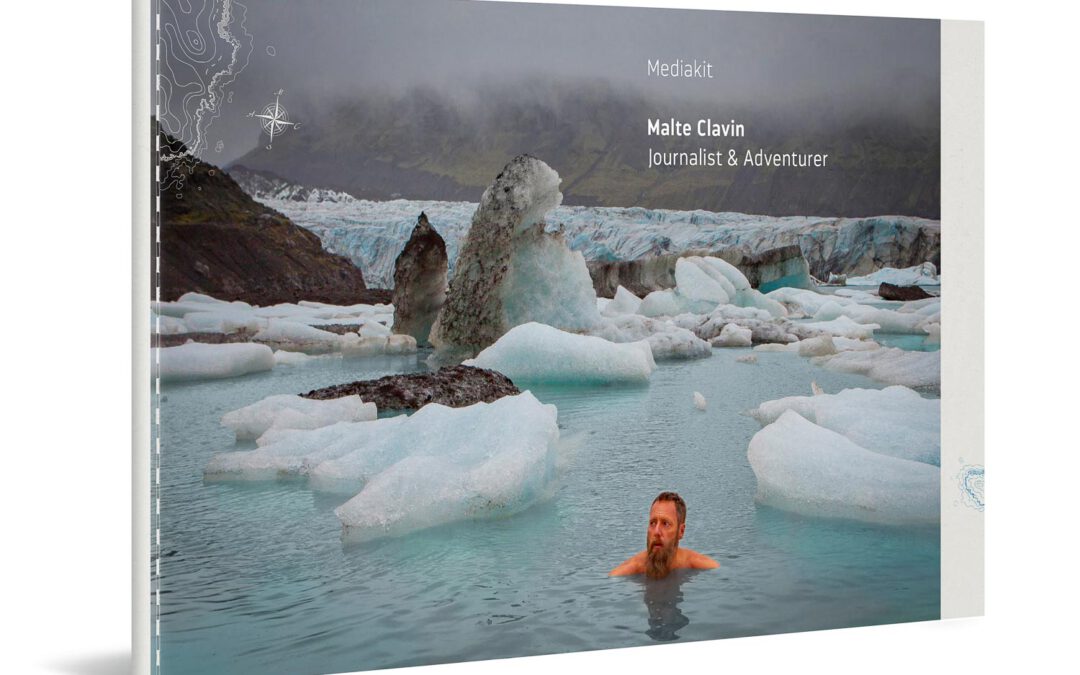
Pure inspiration
My new media kit 2025
< 1 Min.In this brand new 28-page media kit, I show you my work as an adventure journalist and speaker: Expeditions, travels, challenges – everything that excites me. Let yourself be inspired.
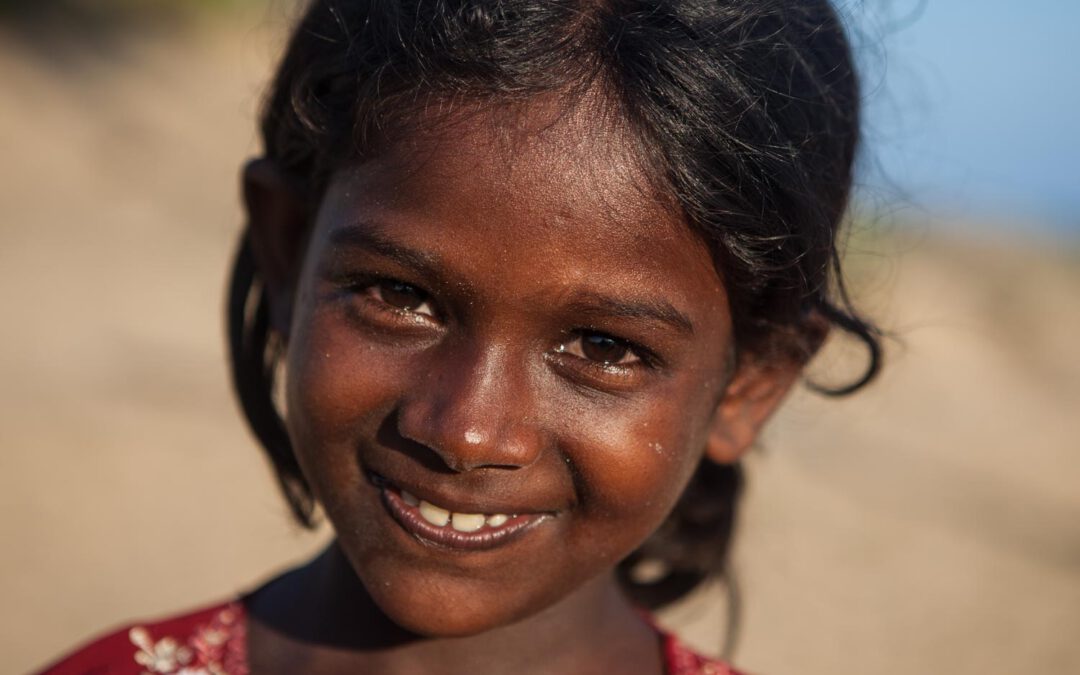
Pearl in the Indian Ocean
Sri Lanka photo gallery
< 1 Min.Sri Lanka: a small, extremely diverse country with the size of Bavaria. The tropical island delights with paradisiacal beaches, mountains up to 2,500 metres high, historical sanctuaries and an exuberant flora and fauna. I spent 5 months there with my family.
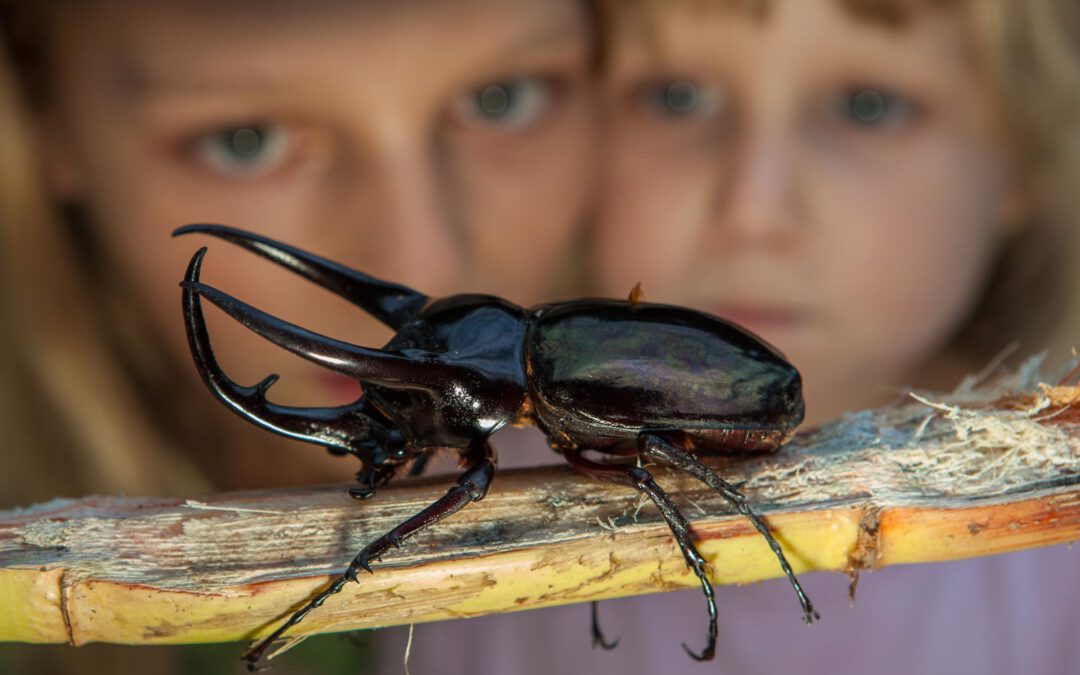
Publication in the Globetrotter-Magazine
Borneo – family adventure in the jungle
21 Min.Together with my wife Annette and our daughters Amelie and Smilla, we are looking for big adventures and discoveries off the beaten track on Borneo. And indeed, for weeks we can hardly stop being amazed.

